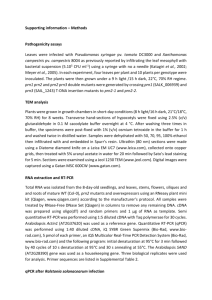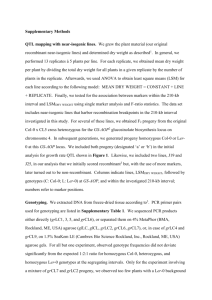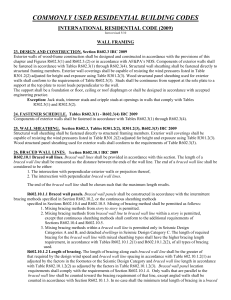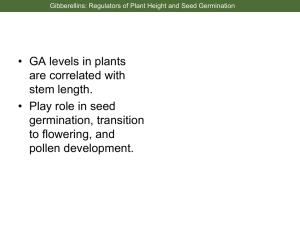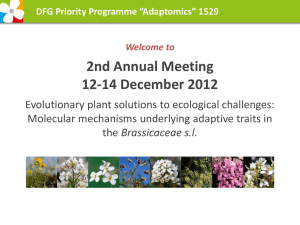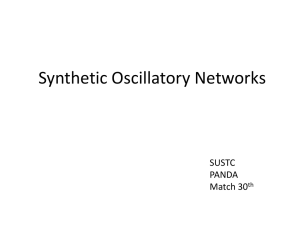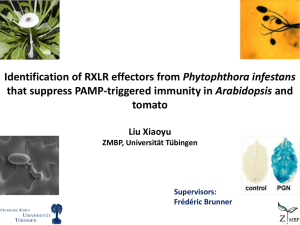tpj12602-sup-0015-Supp_Info_Legends
advertisement
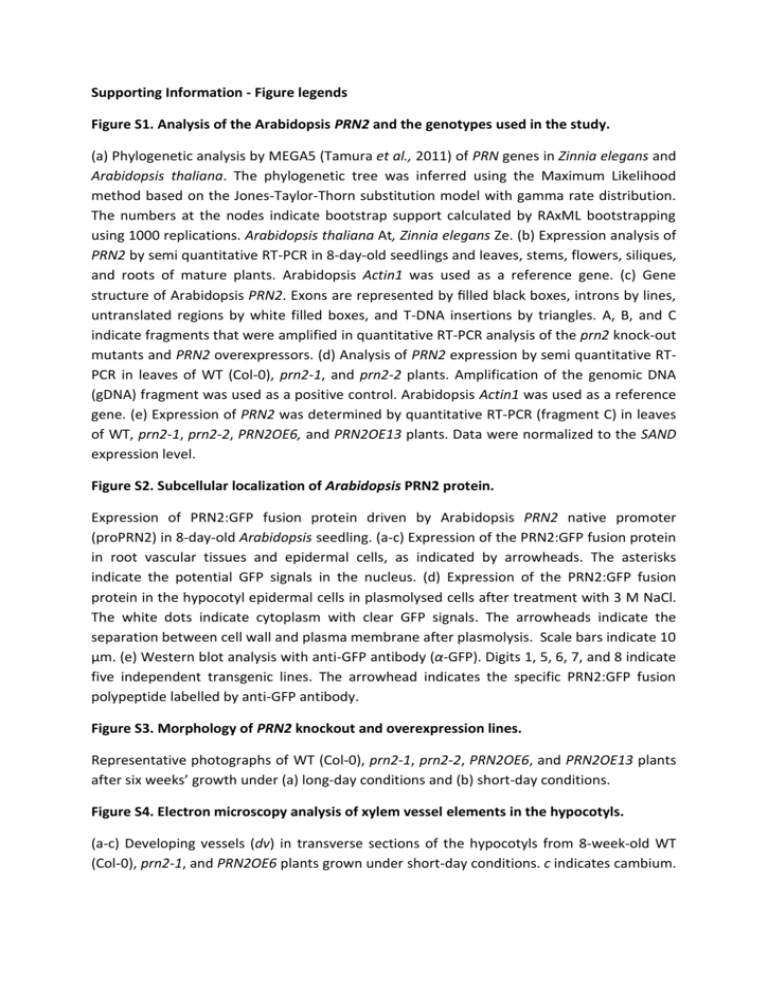
Supporting Information - Figure legends Figure S1. Analysis of the Arabidopsis PRN2 and the genotypes used in the study. (a) Phylogenetic analysis by MEGA5 (Tamura et al., 2011) of PRN genes in Zinnia elegans and Arabidopsis thaliana. The phylogenetic tree was inferred using the Maximum Likelihood method based on the Jones-Taylor-Thorn substitution model with gamma rate distribution. The numbers at the nodes indicate bootstrap support calculated by RAxML bootstrapping using 1000 replications. Arabidopsis thaliana At, Zinnia elegans Ze. (b) Expression analysis of PRN2 by semi quantitative RT-PCR in 8-day-old seedlings and leaves, stems, flowers, siliques, and roots of mature plants. Arabidopsis Actin1 was used as a reference gene. (c) Gene structure of Arabidopsis PRN2. Exons are represented by filled black boxes, introns by lines, untranslated regions by white filled boxes, and T-DNA insertions by triangles. A, B, and C indicate fragments that were amplified in quantitative RT-PCR analysis of the prn2 knock-out mutants and PRN2 overexpressors. (d) Analysis of PRN2 expression by semi quantitative RTPCR in leaves of WT (Col-0), prn2-1, and prn2-2 plants. Amplification of the genomic DNA (gDNA) fragment was used as a positive control. Arabidopsis Actin1 was used as a reference gene. (e) Expression of PRN2 was determined by quantitative RT-PCR (fragment C) in leaves of WT, prn2-1, prn2-2, PRN2OE6, and PRN2OE13 plants. Data were normalized to the SAND expression level. Figure S2. Subcellular localization of Arabidopsis PRN2 protein. Expression of PRN2:GFP fusion protein driven by Arabidopsis PRN2 native promoter (proPRN2) in 8-day-old Arabidopsis seedling. (a-c) Expression of the PRN2:GFP fusion protein in root vascular tissues and epidermal cells, as indicated by arrowheads. The asterisks indicate the potential GFP signals in the nucleus. (d) Expression of the PRN2:GFP fusion protein in the hypocotyl epidermal cells in plasmolysed cells after treatment with 3 M NaCl. The white dots indicate cytoplasm with clear GFP signals. The arrowheads indicate the separation between cell wall and plasma membrane after plasmolysis. Scale bars indicate 10 µm. (e) Western blot analysis with anti-GFP antibody (α-GFP). Digits 1, 5, 6, 7, and 8 indicate five independent transgenic lines. The arrowhead indicates the specific PRN2:GFP fusion polypeptide labelled by anti-GFP antibody. Figure S3. Morphology of PRN2 knockout and overexpression lines. Representative photographs of WT (Col-0), prn2-1, prn2-2, PRN2OE6, and PRN2OE13 plants after six weeks’ growth under (a) long-day conditions and (b) short-day conditions. Figure S4. Electron microscopy analysis of xylem vessel elements in the hypocotyls. (a-c) Developing vessels (dv) in transverse sections of the hypocotyls from 8-week-old WT (Col-0), prn2-1, and PRN2OE6 plants grown under short-day conditions. c indicates cambium. (d-f) Mature vessels (v) in hypocotyls of 8-week-old, WT (Col-0), prn2-1, and PRN2OE6 plants grown under short-day conditions. White bars indicate 5 μm. Figure S5. Results of pathogen inoculation assays. Representative photographs of: (a) Verticillium dahliae- or mock-inoculated plants at 21 DPI, (b) Botrytis cinerea-inoculated plants at 4 DPI, (c) Rosette leaves infected with Pseudomonas syringae pv. tomato DC3000 (PtsDC3000) or Xanthomonas campestris pv. campestris 8004 (Xcc8004) at 6 and 7 DPI, respectively. Figure S6. BiFC assay of PRN2 and XCP2 interaction in Arabidopsis protoplasts. YFPN, N-terminal part of YFP (aa, 1-155); YFPC, C-terminal part of YFP (aa, 156-239). The two empty vectors, expressing YFPN and YFPC, co-transfected with fusion protein XCP2-YFPC and PRN2- YFPN, respectively, were used as controls. Figure S7. Western blot analysis with XCP2 and RD21 antibody. (a) Western blot analysis with anti-XCP2 antibody (α-XCP2) of protein extracts from Arabidopsis rosette leaves. Input proteins were visualized by Ponceau Red staining onmembrane. The upper arrowhead indicates a 40-kD polypeptide that is likely the immature form of XCP2 and not present in xcp2 and xcp1 xcp2. The lower arrowhead indicates a 30-kD polypeptide that is likely a mixture of polypeptides including mature forms of XCP2 and RD21A, and accordingly is less strongly labeled in xcp2, xcp1 xcp2, rd21a, and rd21ab. (b) Western blot analysis with anti-RD21 antibody (α-RD21) in protein extracts of leaves. Input proteins were visualized by Ponceau Red staining on-membrane. Figure S8. Expression and purification of recombinant PRN2 and XCP2. (a) Coomassie Brilliant Blue staining of recombinant XCP2 (rXCP2) expressed in Escherichia coli. Lane 1, molecular weight markers. Lane 2, total protein extracts with no addition of IPTG (-IPTG) from bacteria harbouring construct pET28a(+)XCP2. Lane 3, total protein extract after adding IPTG (+IPTG) from bacteria harbouring the construct. Lane 4, rXCP2 purified on Ni-NTA beads under denaturing conditions. Lane 5, renatured purified rXCP2. (b) Coomassie Brilliant Blue staining of recombinant PRN2 (rPRN2) expressed in E. coli. Lane 1, molecular weight marker. Lane 2, total protein extracts without adding of IPTG (-IPTG) from bacteria harbouring construct pET28a(+)PRN2. Lane 3, total protein extracts after adding IPTG (+IPTG) from bacteria harbouring the construct. Lane 4, rPRN2 purified on Ni-NTA beads under native conditions. (c) Determination of the optimum pH for the rXCP2 using casein labeled with a fluorescence-probe (BODiPY) as a substrate. The buffers used at the indicated pH were: 100 mM sodium formate (pH 2.0–3.5), 100 mM sodium citrate (pH 4.0–5.5), and 100 mM sodium phosphate (pH 6.0–9.5). All buffers contained 5 mM DTT. Fluorescence emission correlates with rXCP2 activity towards the casein substrate. (d) Stability of rXCP2 in various pH buffers detected by Coomassie Brilliant Blue staining. Figure S9. The stability assay of rPRN2 in the presence of rXCP2. (a) Coomassie Brilliant Blue staining of rXCP2 and/or rPRN2 during a 120-minutes time course of incubation. (b) Western blot analysis of rXCP2 with anti-XCP2 antibody (α-XCP2) during the time course of incubation in the presence or absence of rPRN2. (c) Western blot analysis of rPRN2 with anti-PRN2 antibody (α-PRN2) during the time course of incubation in the presence or absence of rXCP2. Figure S10. Induction of PLCP activity in prn2-1 post-inoculation of R. solanacearum. (a-b) PLCP activity profiling with DCG-04 in protein extracts of leaves from WT (Col-0) and prn2-1 plants challenged by R. solanacearum. Active PLCPs are shown by streptavidin-HRP detection in the absence (a) or presence (b) of E64. T0; Day 0 post-inoculation, DI1(-); unwilted leaves from DI1 plants, DI1(+); wilted leaves from DI1 plants. (c) Input proteins were visualized on a Coomassie Brilliant Blue (CBB)-stained protein gel. Figure S11. Expression of XCP2 after infection with a compatible R. solanacearum strain. Col-0 plants were challenged with the virulent strain GMI1000. Nd-1 plants were challenged with the virulent strain GMI1000 ΔpopP2. Relative expression of XCP2 was analyzed by qPCR at 0 (T0), 12, 24, and 96 hours (H) after inoculation as well as in DI1 and DI3 plants. The experiment was repeated two times in the Col-0 plants with similar results. Table S1. Results of yeast two-hybrid screening using the full-length Arabidopsis PRN2 as a bait. Table S2. All primer sequences used in this study. Supporting Information Methods S1.
